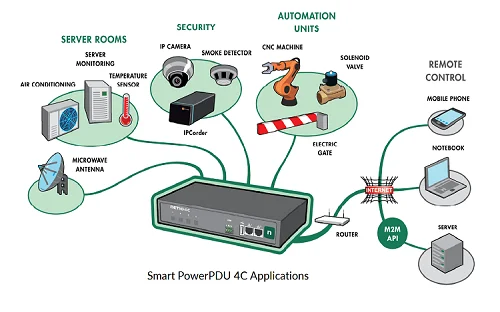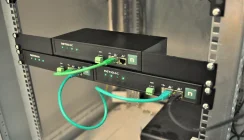How Smart Power Strips Can Improve Energy Efficiency and Power Control
The Internet of Things (IoT) provides opportunities for organisations to rethink how they monitor and control their power and energy usage. There are significant advantages to be gained, all of which have ‘green credentials’ including improving energy efficiency and lowering carbon footprints. There are others in terms of improving customer service and productivity.
Power strips and extension leads have often been thought of and used as power connection devices. They lacked the ‘intelligent’ electronics required to deliver the information and control afford by ‘smarter’ power distribution units, of the type typically used within a server or datacentre rack.
This is no longer the case, however. Advanced design and manufacturing techniques have led to the development of compact electronic circuits that can be incorporated into a range of lower cost socket extension leads, power outlet strips and compact PDUs. Combined with development in connectivity and communications protocols, these advances have opened-up new applications for smarter power strips. Some of these are within the typical server room or datacentre environment but others are at the Edge of computing and IoT networks.
Air Conditioning
Cooling server environments is of paramount importance. With increased remote working, there is a greater need for remote monitoring and control. Some organisations may also decide to deploy extra AC units as additional protection for high temperature days during summer months.
Using a smart power socket with remote control functionality allows additional standby air conditioners to be powered-up remotely as required. The power-up sequence can be initiated manually or automatically when the room temperature exceeds 25°C and powered-off after a set-time running back to within 18-25°C.
Whilst control is via a smart power socket, the temperature monitoring is achieved by a sensor plugged into an environment monitoring device running a LUA script. The script can be set to check the temperature every 10seconds or some other time-period as required.
If the temperatures do not exceed the threshold, the standby AC unit remains off, saving energy and helping to reduce overall running costs.
For more information on LUA visit: https://www.lua.org/
Smart Office Automation
Many offices and homes leave their electronic and IT devices in ‘Standby’ or ‘ON’ mode when not in use i.e. at the end of a working day. This may be required for key applications within a network environment. However, even in standby mode small amounts of electricity are being drawn from the local mains power supply.
Using smart power sockets with automatic schedules allows for ‘Night-time’ and ‘Weekend’ modes to be activated. These can help to reduce overall energy usage and improve operating costs as devices are either put into their standby modes or disconnected from the mains power supply.
Colocation Server Monitoring
Colocation datacentres charge bill their clients for services provided including electricity consumption. The per socket energy consumption metering available using smart power strips and intelligent PDUs allows for accurate billing to within +/- 1% of the kWh used. Monitoring server usage per socket outlet allows for more accurate capacity planning and even load shedding during an emergency or demand for additional computing power. In addition, smart outlets can be remotely rebooted or turned ON/OFF to provide clients and colocation IT managers to have complete control of the IT loads.
Lighting Controls
Lighting is another electrical circuit within a building that can be controlled via automated smart socket control. Consider a restaurant booking system. These tend to be terminals at the ‘front-of-house’ and within the restaurant itself. When connected via a communications script to a network of IP-interfaced smart power sockets, the sockets themselves can be used to turn-off a specific light over a table to show it is unoccupied or turn the light on to show the table has been allocated and is therefore not available. This is a quick and easy way for restaurant staff to see which tables are available for walk-in clients.
Manufacturing and Process Automation
Within an industrial automation or food processing plant, there may be devices that only require power-on at set times in the manufacturing process or that can be shutdown at night to reduce energy consumption. The use of smart power devices and the most appropriate communications interfaces and protocols including MODBUS provide an ideal power management solution for manufacturing sites.
Laboratories, Scientific and Clean Room Environments
In such applications there are often systems where smart sockets can provide a high degree of digital remote control. Devices can be easily monitored and switched ON/OFF remotely via web interface or one of several Machine2Machine (M2M) protocols available and supported by software systems within the application. Power-up sequencing is also possible to prevent nuisance circuit-breaker tripping and/or support the process requirements within the application. Being able to dynamically control devices, removes the need to manually connect or disconnect them. In a clean room environment this also removes the need to enter the facility.
Advertising and Entertainment Multi-Media IT Systems
There are many areas of society now that are subject to the application of more IT-led application and entertainment. Car show rooms are one example where there is a greater use of multi-media displays, controlled lighting, and music to support product launches. Any device connected to a smart power socket can automatically or manually controlled to support the event and often at a fraction of the cost compared to a bespoke program.
Advertising kiosks and display booths are another example of high-impact IT-based system that can be remotely controlled and instructed to turn ON/OFF when required. Powering down when no-one is around i.e. the middle of the night, not only reduces light pollution and energy consumption but also reduces the wear and tear on the lighting and display components.
A similar application is audio systems within multiplex cinemas. If there is no film, music or advertisements playing, a smart power strip can be used to disconnect individual parts of the audio system. Energy efficiency dramatically improves, and electricity bills are reduced proportionately.
Energy savings of up to 30% may be available from the deployment of smart power management devices. Installation costs may also be low if there is a local Wi-Fi system.
Power WatchDog Functionality
Smart power devices may also feature a built-in IP WatchDog function. This is used to monitor whether the connected load is connected to the local Wi-Fi. If there is a loss of communications, power sockets can be disconnected for 30seconds to reboot powered systems. This same functionality can also be used to restart network routers, switches, microwave links and IP cameras.
Summary
There is today a greater need to remotely control power to connected devices. Remote working is just one example. Whilst server rooms and datacentres will typically use intelligent PDUs to provide this functionality, there are wider office and field-based applications where smart power devices can help to improve operational efficiency, reduce power consumption and better look after the wellbeing of its employees and customers. The use of M2M protocols also provides the facility for third-parties to interface and develop their own applications, in whichever field they need to deploy smart power control and management.

























